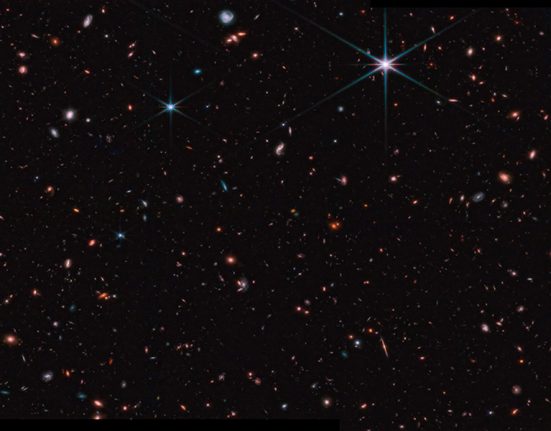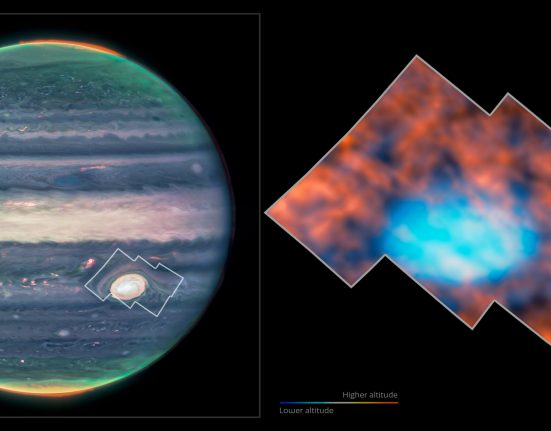
NASA/ESA/CSA/Steve Finkelstein (UT Austin)
A multinational team of astronomers has analyzed images from the James Webb Space Telescope (JWST) and found that massive galaxies existed in greater numbers than previously expected in the early universe. Their results add to a growing body of evidence for unexpectedly large galaxies. abundant early, high mass galaxies that has led astronomers to re-evaluate models of galaxy formation and evolution.
As light travels through the expanding universe, its wavelengths shift toward the redder end of the spectrum in what is known as red shiftAs a result, distant galaxies, which originally emitted ultraviolet and visible light, appear to us in infrared wavelengths. Thanks to JWST's sharp infrared vision, we can now see more than ever before.
The new study in the Astronomical Magazine The study is based on two sets of JWST observations made in 2022 in near- and mid-infrared wavelengths. The researchers found 261 massive galaxies in those observations and looked at how their number changes over cosmic time.
The team was careful to look only at galaxies whose central supermassive black holes are not feeding. Light from gas flowing into such black holes can obscure starlight, making the galaxies appear more massive than they really are. The light from galaxies with quiet black holes, by contrast, comes almost entirely from stars.
The researchers grouped the galaxies by their distance and found that the number of massive galaxies increases over cosmic time, in line with what models of galaxy formation predict. This is because galaxies need time to grow in mass, either by merging with other galaxies or forming their own stars.
But at sufficiently large distances—that is, when the universe was less than 1.5 billion years old—there is a surplus of massive galaxies compared to what is expected.
The fact that the models fail in the early universe “may not be very surprising,” notes Claudia Lagos (University of Western Australia), who was not involved in the study. After all, she notes, those models were designed to reproduce observations of the present-day local universe, not the long-gone universe whose red-shifted light is picked up by JWST.
It is not clear why the results differ from the models. The team behind the study proposes two possible explanations. The first is that gas might have initially cooled and condensed into stars more efficiently than it does today. Modern star formation is a sloppy, wasteful process, with only a fraction of the available mass being transformed into stars. However, this may not have always been the case.

NASA/ESA/CSA/STScI; Image processing: Joseph DePasquale (STScI), Alyssa Pagan (STScI)
As Gerard Mark Voit (Michigan State University), who was also not involved in the study, explains, “In today’s galaxies, star formation is self-limiting because of all the energy it releases, but those limitations may not become apparent until the universe is more than a billion years old.” A simplified conversion would have initially allowed some galaxies to expand to gigantic proportions, even though overall cosmic conditions were very different back then.
A second alternative explanation is that the mass-light ratio The stellar mass of the distant galaxies observed by JWST is smaller than that of the local universe. Astronomers use this ratio to calculate a galaxy's stellar mass distribution and, from that, a number of other properties. Knowing the correct ratio is therefore critical. However, the ratio is ultimately an estimate based on theories of star formation that are known to vary over time. It may need to be updated in response to these new findings.
Lagos considers the team's suggestions to be “very reasonable,” although he cautions that their conclusions depend on precise estimates of the galaxy masses. If they had been overestimated, that would “completely eliminate the tension with the models.”
To determine whether any of these interpretations are valid, more measurements are needed. The study's authors point out that observations of galaxy clusters are a means to improve our understanding of the efficiency of star formation.
What is clear is that JWST, floating in space with its golden mirror like a giant cosmic sunflower, continues to push the boundaries and keep astronomers on their toes. “We are in a new era where all these exquisite observations are making us think a lot about what we are doing and what we really understand about galaxies and structure formation,” Lagos enthuses, “which is very exciting!”









Leave feedback about this